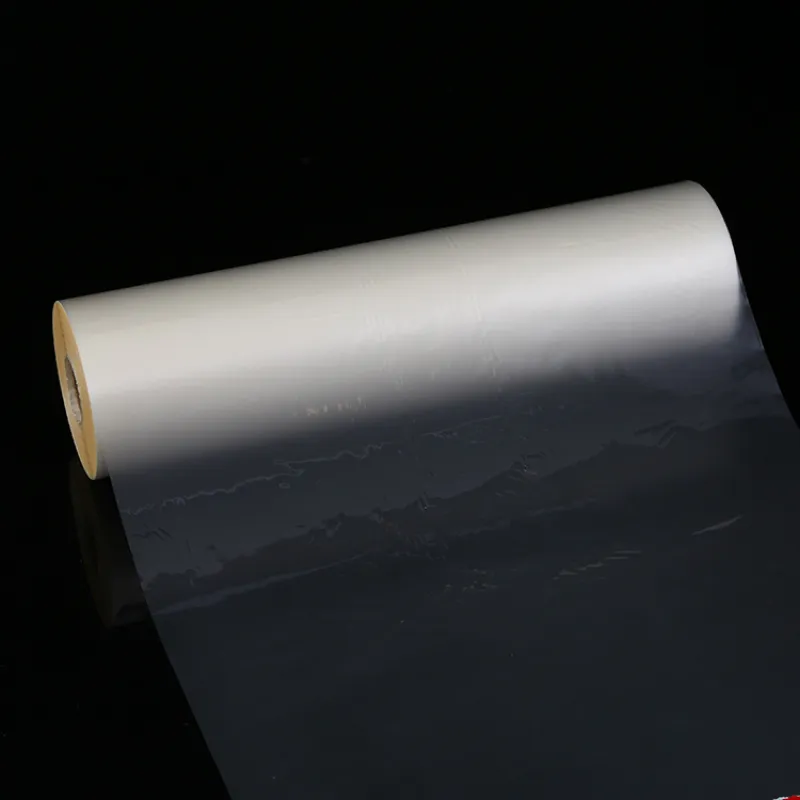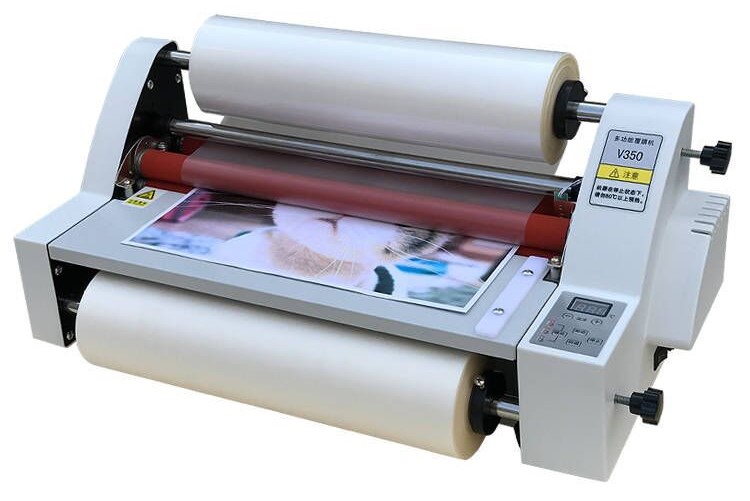
Clear transparent thermal lamination film is made of high-quality polyester (PET) or polypropylene (PP) substrate and is specially designed for hot laminating machines. Just by simple hot pressing, a firm, transparent and wear-resistant protective layer can be applied to the surface of the item, effectively resisting scratches, stains, moisture and ultraviolet fading during daily use, significantly extending its service life and endowing it with a high-end and exquisite appearance.
Product Review:Product Description: Clear transparent hot lamination film
Thermal Lamination Film Roll Product Brief:
Clear transparent hot lamination film is made of high-quality polyester (PET) or polypropylene (PP) substrate and is specially designed for hot laminating machines. Just by simple hot pressing, a firm, transparent and wear-resistant protective layer can be applied to the surface of the item, effectively resisting scratches, stains, moisture and ultraviolet fading during daily use, significantly extending its service life and endowing it with a high-end and exquisite appearance.
Thermal Lamination Film Roll Model Selection:
Advantages of Using Thermal Lamination Film Roll
Elegant matte texture: Say goodbye to dazzling reflections! The unique matte surface treatment effectively scatters light, significantly reduces glare, and provides a soft and comfortable visual experience. This not only enhances the professionalism and sophistication of the work, but also makes the text and images easier to read and appreciate under various lighting conditions.
High-definition transparency protection: The highly transparent substrate ensures that the colors and details of the printed matter below are clearly visible without distortion. Meanwhile, this tough film forms a solid physical barrier, effectively resisting scratches, stains, fingerprints, water stains, dust and tears during daily use.
Hot laminating process: The adhesive is activated by heat and heated and pressurized through a hot laminating machine (not applicable to cold laminating machines) to form a tight, firm and long-lasting bond with the surface of the substrate. The sealed edge effectively prevents moisture and contaminants from entering, providing all-round protection.
Enhance durability: Significantly extend the service life of laminated items, enabling them to withstand frequent flipping, display or transportation while remaining as good as new.
Comfortable touch: The matte surface offers a velvety smooth and non-reflective touch experience, providing a comfortable feel and being less likely to leave fingerprints.
Thermal Lamination Film Roll Specifications:
Substrate type: High-transparency BOPP/PET
Hot Laminate Film Substrate thickness: 19μm / 23μm/other μm
Laser patterns: [For example: 2D dynamic pixel light columns / 3D stereoscopic light patterns/Specific custom patterns]
Hot melt adhesive type: [e.g. Eva-based/PUR A-based] High-performance hot melt adhesive
Adhesive layer thickness: 12 μm
Applicable temperature range: [For example: Bonding temperature 90°C - 130°C] (For details, please refer to the operation guide)
Applicable equipment: Hot laminating and laminating machine, laminating machine with heating roller, etc.
Roll specifications: [For example: Width 310~1880mm, core inner diameter 25.4mm (1 inch), 58mm (2.25inches), 76mm (3 inches), length 100 to 3000M]
Color effects: Transparent rainbow laser/Specific monochrome laser/Other special effects
Reasons for Choosing Matte Transparent Thermal Lamination Film Roll
Enhance professional image: The matte effect conveys a visual impression of refinement, restraint and high-end.
Optimize the reading experience: No interfering glare, making long reading more comfortable.
Stay fresh for a long time: Powerful protective performance keeps your works looking as good as new over time.
Wide applicability: Suitable for a variety of applications that require both aesthetics and practicality.
Let your works exude luxury in a low-key manner and shine forever under protection. Choose matte transparent heat-laminated film to ensure quality!
Thermal Lamination Film Roll Target Customers:
If it is for packaging factories: more emphasis is placed on production efficiency, cost-effectiveness, processing yield, and compatibility with commonly used base materials (gray board, cardboard).
If it is for brand owners/designers: more emphasis is placed on visual effects, design sense, enhancing brand image, and unique selling points (USP).
If it is targeted at a specific industry (such as cosmetics) : emphasize a sense of luxury, touch experience, anti-fingerprint, and compatibility with the contents (anti-permeation).
Specific product parameters: Basic information such as film thickness, common width, roll length, and storage conditions can be added (if as part of the detailed specification sheet).
Highlight specific textures/effects: If there are star textures (such as specific leather textures, special metallic effects), they can be described separately as key points.
Emphasize customization: If the company's strength lies in custom development, it is necessary to prominently highlight "Support for exclusive texture customization" in the description.
Add certification information: If there are specific food safety certifications (such as FDA), forest certification (FSC), etc., be sure to add them.
Thermal Lamination Film Roll If Using:
1. Turn the pressure regulator handle on the box on both sides of the cold press machine, separate the upper and lower two axes, put the picture to be mounted and the cold press film into the two axes at the same time, turn the pressure regulator handle, so that the upper axis moves parallel down, when the pressure regulator handle feels suddenly relaxed, it means that the upper and lower two axes have been in contact, please do not continue to press down. Simply tighten the pressure regulator gently. If the pressure continues, the shaft will be deformed and the operation will fail
2. After the pressure is adjusted, the graph between the two axes and the cold-pressed film are withdrawn from between the two axes. Prepare to press the film.

Question 1. When a large area of the screen has the feeling of "fog"
1. Insufficient film pressure -- adjust the pressure of the cold mounting machine;
2. The two ends of the cold laminating machine are not smooth -- adjust the adjusting screws of the distance between the cold laminating machines to achieve equal distance;
3. Over-photo paper - the surface of the photo paper is uneven, generally about 25 degrees, placed 2-3 hours will automatically disappear, the higher the temperature will disappear faster;
4. Over PP glue --A. hand touch PP glue screen if there is no "rough" feeling, then according to the above method; B. There is a "rough" feeling that requires more PP backing glue;
5. Glue viscosity is not good at low temperature --A. Improve the use of ambient temperature. B. Replace the cold mounting film
Question 2. When there is a "white spot" behind the screen
1. The glue is not sticky enough --A. Increase the ambient temperature,B. Replace the cold mounting film;
2. Thin glue - the general distance is not long, the probability of greater before and after shutdown, generally pull off a few meters;
3.PP adhesive surface hand touch "rough" feeling --A. Replace PP adhesive,B. Or use studio film over the picture;
4. There is dust in the air --A. Purify the operating environment,B. Close the blower or air inlet source;
5. Water droplets (such as saliva) inadvertently splash on the surface of the spray painting --A. Pay attention when operating, especially when speaking, do not face the picture,B. Air temperature in dry environment, such as air conditioning, hot fan or ventilation.
Question 3. When there are "bubbles" immediately after painting
1. The glue does not "mature" -- change the cold mounting film
Question 4. It is fine after painting, but there are "bubbles" after leaving it for a while (or the next day).
1. The glue is not "matured" thoroughly -- open the cold mounting film
Pack and place in the air for 2-5 days to allow the glue to fully "mature" under natural conditions;
2. The picture is not sufficiently dry, especially in winter, because there are antifreeze components in the winter ink, which is not easy to volatilize completely.- Let the picture be fully dry, the general winter time is twice as long as summer and autumn above, and then over the painting (must pay attention to dust);
3. Large area single color such as: all black/all red, etc. --A. Light color,B. Replace ink,C. Fully dry the picture (completely dry),D. heat the picture,E. replace the more viscous cold mounting film, the thinner the better.
4. The ambient temperature is low, so that the cold laminating film surface is too hard -- improve the ambient temperature when using;
5. Cold mounting film is too thick -- replace it with a thin cold mounting film;
6. Roll up immediately after painting, the glue and the picture are not fully integrated - after painting, place it flat for more than 45 minutes and then roll it up.
7. Aging glue -- Replace the cold mounting film.
If you have any questions about our head Stickers material products, please feel free to contact us.
Customer Feedback(1)
The Clear Transparent Thermal Lamination Film Roll is amazing! It’s perfect for giving my projects a smooth, glossy finish while keeping them protected. It’s easy to use, and the clarity is top-notch. I trust Ownlikes for all my lamination needs!